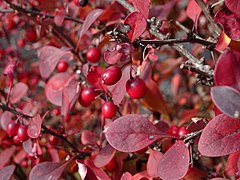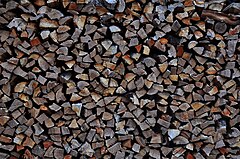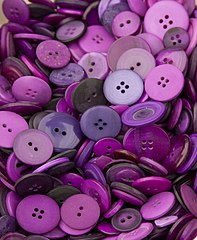Colors
This is description of colors in Toki Pona. The color words featured in the book Toki Pona: The Language of Good can roughly be compared to the CMYK color model. The words for hue—loje, jelo, laso—describe a red–yellow–"grue" system. pimeja and walo are often used as modifiers to describe shades and tints, respectively.
Core words
kule
 | |
| Pronunciation | /ˈku |
|---|---|
| Usage | 2023: Core (99% → )2022: Core (99%) |
| Book and era | nimi pu |
| Part of speech | Content word |
| Codepoint | U+F191E |
The word kule is a core word relating to hue, colours, pigments or paint.
kasi ni li kule seme?kasi ni li kule seme?
What color is this plant?
By analogy, kule is sometimes extended to refer to any intrinsic or sensory attribute, such as composition, sensory information (hue, smell, flavor, timbre, texture), or gender identity. The word poki ("container") is used as an antonym for this sense, meaning any extrinsic attribute. Compare the English phrase "to put someone in a box".
The word kule is derived from Acadian French couleur.[1]
loje
 | |
| Pronunciation | /ˈlo |
|---|---|
| Usage | 2023: Core (99% ↗︎ )2022: Core (98%) |
| Book and era | nimi pu |
| Part of speech | Content word |
| Codepoint | U+F192B |
loje is used for red and red–adjacent colors, including pinks and magentas. It usually ranges from reddish shades of purple to reddish shades of orange and brown.
Other colors that can be described as loje include burgundy, crimson, fuchsia, maroon, rust, salmon, scarlet, and vermilion.
The word loje is derived from Dutch rooie, an inflected form of rood.[1]
jelo
 | |
| Pronunciation | /ˈje |
|---|---|
| Usage | 2023: Core (100% ↗︎ )2022: Core (98%) |
| Book and era | nimi pu |
| Part of speech | Content word |
| Codepoint | U+F1912 |
jelo is used for yellow and yellow–adjacent colors. It usually ranges from yellowish shades of orange and brown to very yellowish shades of green.
Other colors that can be described as jelo include amber, gold, and lime.
The word jelo is derived from English yellow.[1]
laso
| Pronunciation | /ˈla |
|---|---|
| Usage | 2023: Core (99% ↗︎ )2022: Core (98%) |
| Book and era | nimi pu |
| Part of speech | Content word |
| Codepoint | U+F1923 |
laso is used for turquoise and turquoise–adjacent colors, including blues and greens. It usually ranges from greens to bluish shades of violet. Toki Pona lacks the disintinction betwen blue and green, linguistis call this umbrella color term "grue".
Other colors that can be described as laso include aquamarine, azure, cobalt, cyan, indigo, lime, mint, navy, olive, and teal.
The word laso is derived from Welsh glas, meaning only "blue" in modern Welsh, but used to cover colors like green and silver.[1]
walo
| Pronunciation | /ˈwa |
|---|---|
| Usage | 2023: Core (100% ↗︎ )2022: Core (98%) |
| Book and era | nimi pu |
| Part of speech | Content word |
| Codepoint | U+F1972 |
walo is used for any pale or light color, especially those approaching white.
Note that while walo and suno can both be translated as "light", they mean different things. suno means light itself, and it can be used as an adjective to describe objects that give light. On the other hand, walo refers to the lightness of color alone.
The word walo is derived from Finnish valko-, the combining form of valkoinen, meaning "white".[1]
pimeja
| Pronunciation | /ˈpi |
|---|---|
| Usage | 2023: Core (100% ↗︎ )2022: Core (99%) |
| Book and era | nimi pu |
| Part of speech | Content word |
| Codepoint | U+F194F |
pimeja is used for any dark color, especially those approaching black.
pimeja is also used for "darkness", as an antonym of suno ("light"), and can be used to describe shadows, unlit spaces, and the night.
The word jelo is derived from Finnish pimeä, meaning "black".[1]
Nonstandard words
kapesi
 | |
| Pronunciation | /ˈka |
|---|---|
| Usage | 2023: Obscure4, Rare6 (19% ↗︎ ) |
| Book and era | nimi ku lili (pre-pu) |
| Part of speech | Content word |
kapesi is a rare word for brown and gray. It is derived from either Cantonese 咖啡色 (gaa3 fe1 sik1) or Mandarin 咖啡色 (kāfēisè), meaning "brown" (literally, "coffee color").
In practice, it is more commonly used for browns than grays, because browns are usually hard to describe with pu words, while grays can easily be described as pimeja walo ("light black") or walo pimeja ("dark white").
unu
 | |
| Pronunciation | /ˈu |
|---|---|
| Usage | 2023: Obscure4, Rare6 (16% ↗︎ ) |
| Book and era | nimi ku lili (post-pu) |
| Part of speech | Content word |
unu is a rare word used for purple and purple–adjacent colors, including violets, and sometimes magentas and indigos. It was coined by jan Sonja in 2020 and is derived from Indonesian ungu.[2]
Color mixing
Color words can be combined into phrases to "mix" their respective colors and describe more specific colors more closely. It is usually thought of in a subtractive color space, which works like mixing paints or ink (whereas an additive color space works like shining colored spotlights).
For example the phrases laso loje ("reddish blue") and loje laso ("bluish red") are common ways to say purple. They may refer to somewhat different hues, leaning in the direction of the head (first) noun. In this case, laso loje would describe more bluish purples, and loje laso would describe more reddish purples.
References
- ↑ 1.0 1.1 1.2 1.3 1.4 1.5 "Word Origins". tokipona.org. Archived from the original on 8 August 2002.
- ↑ jan Sonja. [@sonjalang] (23 December 2020). Message posted on the
#toki-ponachannel in the ma pona pi toki pona Discord server. "ken la nimi sin li unu tan nimi ungu pi toki Intonesija". Discord.





